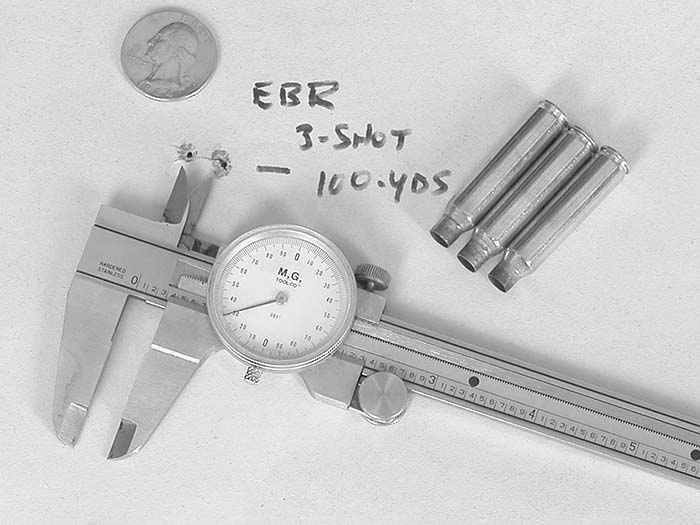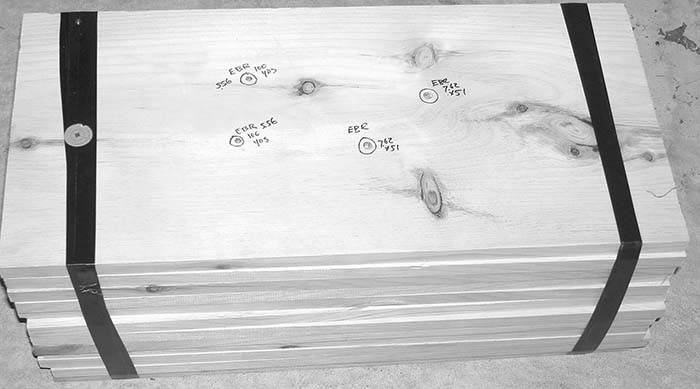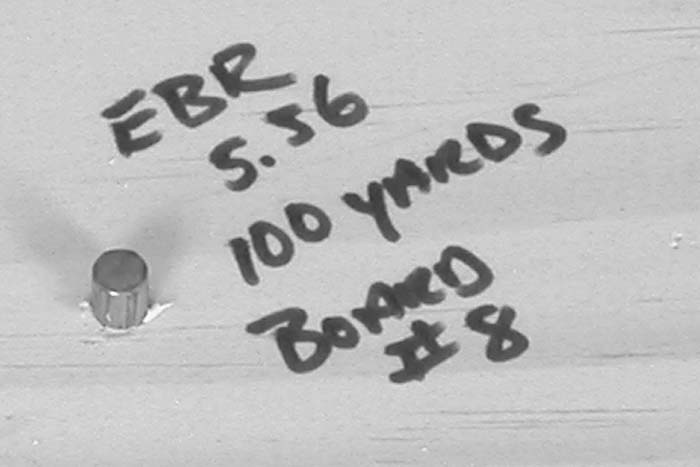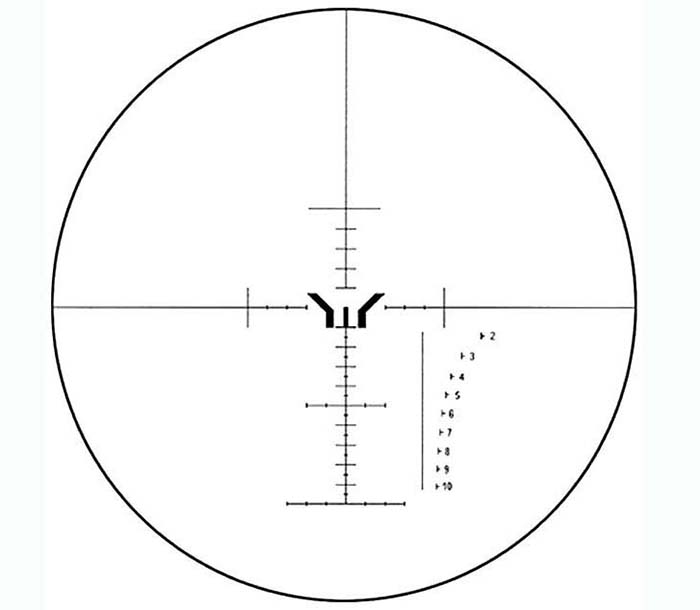Text & Photos by Jeff W. Zimba
With the ongoing War on Terror, weapons and their operators have become frequent topics in the media. Words like “snipers”, “silencers” and “confirmed kills” have become fodder for discussion by people well outside our industry. It will only be a matter of time before Hollywood brings their version of “fact” into the mainstream even more. For many people involved with military firearms, all this late attention is certainly interesting but those “new” buzzwords have been part of their daily existence for years. Far outside the limelight and away from the television cameras, numerous people inside the firearms community have been active participants in this new battlefront, filling the need for special requests due to this new and ever changing fighting environment. One such company is Engel Ballistic Research of Smithville Texas.
Engel Ballistic Research (EBR) is a Type 10 Firearms Manufacturer and Type 20 High Explosives Manufacturer with a focus in specialty ammunition. With a product line that starts with 9x19mm subsonic and frangible ammunition and goes all the way up to specialty 40mm loads, excellence and attention to detail remain their number one priority.
Whit Engel, President of EBR has been involved in the ammunition manufacturing business for almost 25 years. Upon completing a gunsmithing course by McBride’s of Austin in the early 1980s, Engel immediately opened his first gunshop. He continued to stay active in the custom gunsmithing field until he was asked to research specialty ammunitions, primarily for military and law enforcement applications in the early 1990s. Initially doing business as Southern Armory, Engel Ballistic Research was founded and incorporated in September of 1997, picking up the Southern Armory business and shifting the focus to the manufacture of consistent and accurate subsonic ammunition.
Recently, their research and development has included an emphasis in specialty shotgun ammunition. Three new rounds are currently being unveiled, including a new “entry” round. A big concern of operators when they make entry into populated areas is ammunition over-penetration. This new entry round allows the full energy of a 12-guage slug (1,625 ft./lbs.) to be completely expelled in the intended target with no concern of residual damage. As a demonstration of this amazing feat, there is a video you can watch on the EBR website where they shoot one of these slugs into a watermelon placed directly in front of a piece of cardboard. While the watermelon is completely destroyed and turned into a red mist, there is no damage to the cardboard other than a few small dings. The dent from the wad causes more of a dimple than anything left from the projectile.
Principals of Subsonic Ammunition
Subsonic ammunition has the immediate advantage of being much quieter than standard, supersonic ammunition. The sonic crack heard when firing supersonic ammunition can be as loud as the noise caused by the expulsion of the gasses from the firing itself. In the absence of this supersonic crack, especially when combined with the use of an effective sound suppressor, the signature, or residual noise, caused by the shooter is drastically and dramatically reduced.

The combination of a silencer and effective subsonic ammunition has obvious advantages for use in a military application such as sentry neutralization and sniper initiated assault. This combination also has several other uses that may not be as obvious. For police tactical teams, the use of suppressed firearms can include taking out a motion sensor light prior to crossing the path of an otherwise dark driveway so as not to announce a presence. They are also effective in dispatching menacing, sick or injured animals in populated areas where the sound of a gunshot would create additional problems.

Many people also like to shoot with suppressed firearms in a recreational setting just to have the convenience of the absence of unnecessary noise, and in many cases hearing protection is no longer necessary. The use of sound suppressors are extremely beneficial in teaching new people to shoot. The loud noise of a firearm is often a major source of intimidation to a new shooter and, in its absence, the shooter will typically not have to overcome a flinch and will shoot better right away. This has often been the case when dealing with women and children who have not had any experience in handling firearms in the past.
Subsonic Ammunition Performance
The threshold where ammunition will remain subsonic is generally referred to as being less than 1,050 feet per second (fps), although this is affected by temperature and atmospheric conditions. While this may be the case at the temperature of 0ºF, it can increase to as high as 1,160 fps at 100ºF. Refer to the simple table created by Dr. Phil Dater of Gemini Technologies in Boise Idaho.
The use of subsonic ammunition is immediately noticeable on the range by the lack of residual noise upon firing. It is, however, far from the only important characteristic. Consistency is a key factor to achieve the accuracy to actually have the round impact where it is intended. Without this accuracy, the operator might as well not bother to shoot at all as the desired effect of neutralizing a dangerous threat could not consistently be accomplished. Another important factor is that the round should actually stay as close to the speed of sound as possible without going over it, to insure the highest amount of terminal energy with the least amount of noise.
Even though every firearm and ammunition combination can result in different results, minor differences when dealing with subsonic ammunition are often magnified and exaggerated. A rough bore, an out of spec chamber, minor barrel blemishes and other abnormalities can create larger problems than typically apparent when using standard, supersonic ammunition. With the understanding that every gun is different, it is wise for the owner of a firearm that will be used with subsonic ammunition to spend a lot of time with it and learn exactly how it will perform well before the actual performance is a necessity.

Subsonic ammunition is going much slower than standard, supersonic ammunition. This means several things. The slower speed creates a longer time interval from the time the trigger is squeezed to the time the target is impacted. With gravity retaining the same amount of force regardless of the speed of the projectile, bullet drop is much more pronounced. The point of impact is going to be much different with subsonic ammunition and the rifle must be sighted in specifically for the ammunition you will be using. The use of a good Mil-Dot scope can take some of the guesswork away and even allow the shooter to use the same settings with both types of ammunition. In the case of the EBR rifle ammunition, it is suggested that a rifle zeroed for high-velocity ammunition at 100 yards can (in many guns) use the aiming point of 3 Mil-Dots down from the crosshair as a 50-yard zero and 4 Mil-Dots down at 100 yards. This certainly varies slightly depending on the platform used but it is a good starting point and surprisingly accurate. This was found to be the case when SAR tested the EBR .308 Thumper. After firing only one shot at 100 yards with the rifle sighted in for M118 Lake City Special ball, the new zero was recorded on the graduation scale of the BW Optic Y-TAC scope and bulls eyes were then immediately recorded with no manual scope adjustment at all. After conducting this test on the advice of Engel Ballistic Research, it makes sense to have a multi-use firearm with the assistance of a Mil-Dot or similar scope.
Range Time
EBR provided Small Arms Review with samples of their 5.56x45mm Ultra Stealth and 7.62x51mm Thumper for evaluation. The test rifle used for the 5.56x45mm ammo is a custom AR-16 type rifle built by Small Arms Research for use as a test platform. It has a free-floating, 14-inch barrel rifled 1 in 7 to stabilize heavier loads and is equipped with a TAC-ORD MS-556 stainless steel sound suppressor. The optics are an original Tasco 3×9 rubber armored DELTA Elite scope as offered by Colt. The test rifle utilized for the 7.62x51mm ammo is a DPMS LR-308 with a 20-inch stainless, free-floating bull barrel rifled 1 in 10; the recommended rifling for dual use with both subsonic and supersonic loads. The optics are a BW Optic Y-TAC 4×10 power scope. Both rifles perform very well with standard ammunition.

The outside temperature during the test was 32º F at an altitude of 165 feet above sea level. The humidity was at 52% with a barometric pressure of 29.20 Hg.
The first test was to measure muzzle velocity. In order to have some idea where the EBR ammunition stood in relation to standard Hi-Velocity ammunition, several strings with several types of ammo were fired. The results are listed in accompanying charts but, in summary, the EBR Ultra Stealth 63-grain 5.56x45mm averaged 1,042 fps, with factory high-velocity ammo averaging 2,843 fps. The EBR Thumper 180-grain 7.62x51mm averaged 968 feet per second with standard high-velocity ammo averaging 2,642 fps.
The second test was to measure accuracy. 3-round groups were fired with no barrel warming prior to the first shot. As both rifles are semiautomatic black-rifle variants, and with the outside temperature at the freezing mark, bench-rest accuracy was not expected. The results, however, were pleasantly surprising. The first round tested was the 7.62x51mm Thumper. This heavy 180-grain round-nose averaged groups of around an inch at 50 yards with some under an inch. At 100 yards the average group was closer to 2 inches with some closer to 1.5 inches. While this performance with a projectile so heavy and traveling so slow was certainly impressive, what happened with the 5.56x45mm Ultra Stealth was nothing short of amazing. The first group at 50 yards measured only .300 inches. It was immediately followed up with a group at 100 yards. This next group measured only .330 inches. That was far below the typical 1 MOA group which should be average under good conditions. Several more groups were fired with similar results and all averaged well under the 1-inch mark. A string was then fired at the 100 yard target using the 50 yard zero to observe the drop. With a 50-yard zero, the 5.56x45mm Ultra Stealth had an average drop of 4.5 inches at 100 yards. The 7.62×51 Thumper had an average drop of 6 inches at the same distance.
The third test was to measure penetration. At this point we knew the rounds were consistent and accurate, but did they have the stopping power necessary to neutralize a typical situation? It was calculated that the EBR Ultra Stealth has approximately 152 ft/lbs of energy at the muzzle with 127 ft/lbs left at 100 yards. The Thumper came in at 374 ft/lbs at the muzzle and 323 ft/lbs at 100 yards. Being so cold, using any wet medium like ballistic gel or wet paper was out of the question to help determine penetration capability, so pine boards were used. Two pine boards (1″x12″x24″) were placed back-to-back and fired on at 100 yards. Both rounds easily penetrated both of them. A stack of 12 boards placed back-to-back and taped together was then used. The 5.56x45mm Ultra Stealth had an average penetration of 5.3 inches into the pine boards with all rounds traveling halfway through the 7th board and into the 8th before coming to a stop. The 7.62×51 Thumper did a little better averaging a little over 7 inches of pine and traveling through 9 pieces, coming to rest in the 10thh piece. One round even went completely through a knot about 4 boards into the stack and traveled 5.695 inches through 7 boards and into the 8th.
Shhhhhhhhh!
Not only does the EBR Ammo perform well in the areas of accuracy and penetration, as the subsonic designation would lead you to believe, it does it with an impressive amount of stealth. Without the electronic equipment available to accurately measure sound at our test range that day, we called on Doug Melton of SRT Arms to check the numbers from some of his past testing. He found that the EBR 7.62 Thumper averages 152db from an unsuppressed platform and 123db when using the SRT Shadow suppressor. For comparison he also measured Remington 180 Grain CoreLokt ammunition and recorded 164db while unsuppressed with 133db when using the same SRT Shadow suppressor. In the case of the EBR .223 Ultra Stealth it came in at 150db unsuppressed and 113 through an SRT Hurricane suppressor. Just for reference, an average Pellet rifle at 10 pumps is in the 122db to 123db range so you may start to get the idea how quiet this ammo really is.
Summary
If you have never used quality subsonic ammunition in the past, you owe it to yourself to indulge a little. With good quality comes a reasonably heavy price so this is not for those who want to expend thousands of rounds in the course of an afternoon. If you are in a line of work where the safety of you and that of your teammates depends on your capability with a rifle, then you may want to consider the EBR line of ammunition. If your intended targets are typically the size of a golf ball (or larger) at 100 yards, than this is the ammunition for you. With a silent delivery and surgical accuracy made possible, whether you use your firearm for special operations to basic animal control tasks, there should be some serious consideration given to the procurement of this ammunition for evaluation. At the time of this writing the 7.62x51mm Thumper ammunition was priced at $450 for 500 rounds. The 5.56x45mm Ultra Stealth was only available to military with no pricing available. Complete pricing and availability of the entire EBR product line can be obtained by visiting their website.

Subsonic and Specialty Ammunition
E.B.R., Inc
Dept. SAR
544 Alum Creek Road
Smithville, Texas 78957
Website: www.ebr-inc.net
E-Mail: sales@ebr-inc.net
SRT Sound Suppressors
SRT Arms
Dept. SAR
1739 E. Broadway Rd. #1-161
Tempe, AZ 85282
Phone: (480)967-6218
Website: www.srtarms.com
E-mail: nac15@springmail.com
Panther LR-308 Rifle
DPMS, Inc
Dept. SAR
3312 12th Street SE
St. Cloud MN 56304
Phone: (320) 258-4448
Fax: (320) 258-4449
Website: www.dpmsinc.com
E-Mail: dpms@dpmsinc.com
Y-TAC Scopes
BW Optic
Dept. SAR
P.O. Box 355
Simpsonville, SC 29681
Phone: (864) 297-4137
Fax: (864) 458-8324
Website: www.bwoptic.com
E-mail: bwoptic@aol.com
PACT Timers
PACT, Inc.
Dept. SAR
P.O. Box 535025
Grand Prairie, TX 75053
Phone: (800) 722-8462
Website: www.pact.com
| This article first appeared in Small Arms Review V9N9 (June 2006) |










